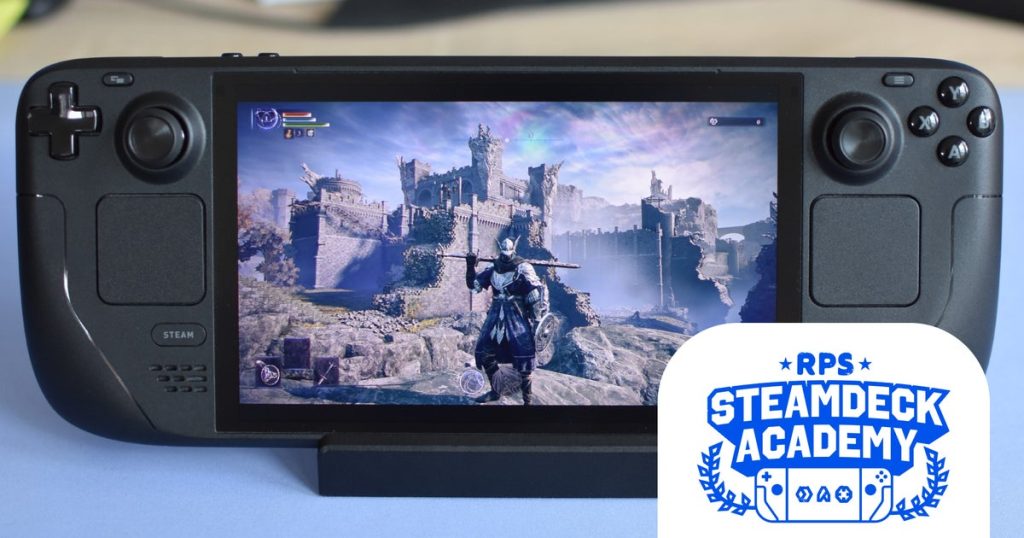Elden Ring Nightreign might replace its source material’s sprawling RPG exploration with a mad dash around tightly-nestled hotspots, but under the bonnet, this is still essentially just Elden Ring with a quicker sprint and character models of hitherto-unseen birdpeople. Even the system requirements are, save for a minor CPU bump, a copy and paste job, confirming the feathers aren’t even that high-poly.
As a result, this spinoff runs equally well on the Steam Deck, even appearing to take advantage of the same SteamOS/Proton tweak that made Elden Ring less stutter-prone on Valve’s handheld specifically. My Steam Deck settings guide for the base game works here too, though having been yanked around Limveld at greave-splintering speeds by loothounds Nic and Ollie, I actually think further quality cuts could be prudent. This is FromSoft at their paciest, and it makes sense to help framerates keep up.
Scroll down if you just want those updated settings, though Deck owners should also know that some of Elden Ring’s less likeable quirks live on in Nightreign too. It still, for example, only fills out 1280×720’s worth of screen space even if you have the native 800p resolution enabled. There are also cases of petite text and icons that may require some light squinting, especially on the default map view. Then again, I personally found these readable enough, and you’ll likely end up zooming in on the map to inspect possible looting/bloodshedding sites anyway.

As you’d expect from From, this has all been sympathetically designed around gamepad controls, an approach that suits the Deck just fine. Nightreign’s newfound cooperative focus also refrains from entirely leaving handheld players behind: there’s a perfectly usable Offline Mode (again, just like Elden Ring) that allows for solo expeditions when you take your Steam Deck away from the comfort of a reliable Wi-Fi connection.
That’s not to say it’s suited to lengthy coach trips, as Nightreign drained my LCD Steam Deck’s battery from 100% to empty in 1h 22m. That’s 11 minutes shy of the original game (with both running at 50% speaker volume with 50% screen brightness). But, while it lasts, it plays well, runs well, and takes up less than 21GB of SSD space once installed, so you probably won’t need help from a microSD card. Maybe a power bank, but not a microSD.

Elden Ring Nightreign Steam Deck settings guide
Nightreign’s visual settings are almost another perfect match for Elden Ring’s, with the exception of ray tracing being removed. No big loss there. General performance is familiar too: on the Low preset, almost all of your time will be spent in the 30-45fps range, and since a lot of those settings only impose minor strain on framerates, you can still get Nightreign looking a lot nicer than Low while still keeping above 30fps.
The settings I’ve previously suggested for the base game (and Shadow of the Erdtree) tended towards High quality, with a handful of deeper cuts to avoid dips into the twenties. Those are fine to try again, though again, Nightreign’s battle royale and roguelike influences make it a much faster, action-heavy shindig than OG Elden Ring. Which is saying something, when your primary means of interacting with the latter’s world was thwacking it with surfboard-sized swords. Here, then, I’d recommend going a little further with quality reductions – not to the point of looking like Low, but enough to wring out a few more frames, which will in turn make for performance that fits that non-stop tempo.
- Texture quality: Medium
- Antialiasing quality: High
- SSAO: Medium
- Depth of field: High
- Motion blur: Off
- Shadow quality: Medium
- Lighting quality: Medium
- Effects quality: Medium
- Volumetric lighting quality: Low
- Reflection quality: Maximum
- Water surface quality: High
- Shader quality: Medium
- Global illumination quality: Medium
- Grass quality: Medium
These settings usually get me 35-40fps on both the Steam Deck and Steam Deck OLED, compared to 30-35fps with my previous settings list. 5fps doesn’t sound like a lot but there is a subtle smoothness difference in motion, and in the less demanding corners of the map (think caves and dungeons), you’re more likely to see higher peaks into the forties. Maybe even 50fps-plus, though like my life when Margit shows up, that’s pretty fleeting.


